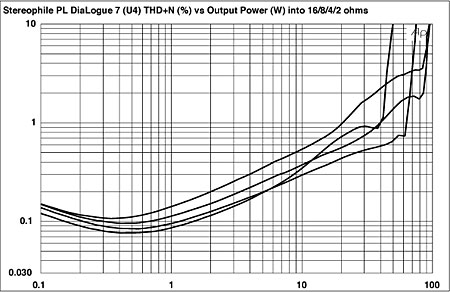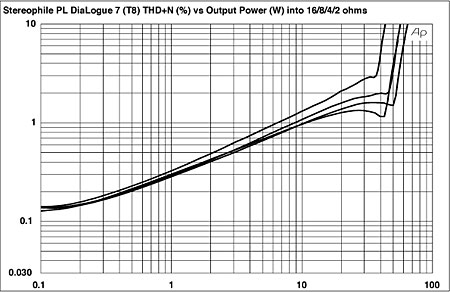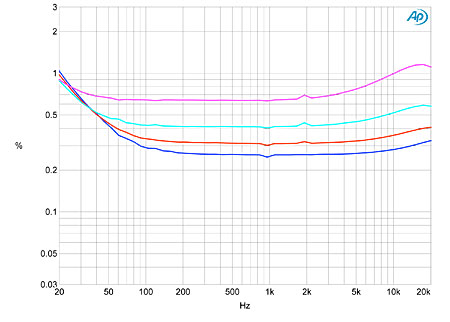| Columns Retired Columns & Blogs |
PrimaLuna DiaLogue Seven power amplifier Measurements
Sidebar 2: Measurements
I examined the PrimaLuna DiaLogue Seven's measured behavior using Stereophile's loaner sample of the top-of-the-line Audio Precision SYS2722 system (see the January 2008 "As We See It" and www.ap.com); I also used my Audio Precision System One Dual Domain for some tests. With three output-transformer taps and two output operating modes (triode and ultralinear), the DiaLogue Seven offers six choices of how it can be used. I performed a complete set of measurements from each tap in triode and ultralinear modes, but have published here only a limited selection of the graphs to illustrate the points I want to make.
The PrimaLuna preserved absolute polarity (ie, was non-inverting) from all transformer taps in both ultralinear and triode mode. As expected, however, the gain varied according to both mode and tap. In ultralinear mode, the voltage gain into 8 ohms was 26.9, 26.3, and 24.8dB, from the 8, 4, and 2 ohm transformer taps, respectively. In triode mode, the corresponding figures were 23.5, 22.1, and 20dB. Even with the generally low gain, however, the preamplifier used with the DiaLogue Seven won't be asked to deliver more than 1.5V RMS to drive the amplifier to its maximum output.
The Dialogue Seven's input impedance was very high, at around 100k ohms in the bass and midrange, dropping to a still-high 70k ohms at the top of the audioband. High is good for a component's input impedance, as this means it won't load down the source component's output in any significant way. High is not good for a component's output impedance, however, and, as with other PrimaLuna amplifiers Stereophile has reviewed, the DiaLogue Seven's output impedance was indeed high. In the worst case, ultralinear mode from the 8 ohm tap, the impedance was 8 ohms across the audioband. Triode mode dropped this to a still-high 4.3 ohms, and in general, changing to an output transformer tap with half the nominal impedance halved the output impedance in both ultralinear and triode modes. In the best case, triode mode from the 2 ohm tap, the PrimaLuna's output impedance was 1.2 ohms, which is still quite high in absolute terms.
The justification for designing an amplifier to have a high output impedance is that the maximum transfer of power occurs when the output impedance is equal to the load impedance. An 8 ohm impedance feeding an 8 ohm load transfers more power to the load than would a greater or smaller impedance. However, there is a price to be paid: because loudspeaker impedances vary considerably with frequency, high output impedances result in significant modification of the amplifier's frequency response, due to the Ohm's Law interaction between the amplifier and loudspeaker impedances. This is illustrated by the gray trace in fig.1, which shows the DiaLogue Seven's frequency response from the 4 ohm tap in ultralinear mode into Stereophile's standard simulated loudspeaker. The response varies by up to ±2.1dB, which will be audible. From the 8 ohm tap (not shown), the response variation was ±3.2dB, which will be very audible. Three other things can be seen in fig.1: first, the DiaLogue Seven features a wide small-signal response that doesn't begin to roll off until >60kHz; second, in ultralinear mode, there is a sharply defined resonant peak around 150kHz, though the height of this peak drops a little with decreasing load impedance; and third, a low-frequency peak starts to develop into lower impedances.

Fig.1 PrimaLuna DiaLogue Seven, ultralinear, 4 ohm tap, frequency response at 2.83V into: simulated loudspeaker load (gray), 16 ohms (magenta), 8 ohms (blue), 4 ohms (red), 2 ohms (cyan). (1dB/vertical div.)
Fig.2 shows the PrimaLuna's response from the 4 ohm tap but with the amplifier now in triode mode. The variation into the simulated loudspeaker is now ±1.25dB, due to the lower output impedance in this mode, and there is now just a vestigial peak around 150kHz. There is also no sign of any lower-frequency peak, and the response is maintained to well above the audioband. At the other end of the spectrum, the low-frequency response starts to roll off below 40Hz, but is still down only 1.4dB at 10Hz. These are well-designed output transformers, the DiaLogue Seven's reproduction of a 1kHz squarewave in triode mode being extremely square, with flat tops and almost no ringing (fig.3). Similarly, a 10kHz squarewave in triode mode offers only small degrees of overshoot and ringing, with very short risetimes (fig.4), whereas in ultralinear mode (fig.5), both overshoot and ringing are considerably more developed, this correlating with the ultrasonic peak in the frequency response.

Fig.2 PrimaLuna DiaLogue Seven, triode, 4 ohm tap, frequency response at 2.83V into: simulated loudspeaker load (gray), 16 ohms (magenta), 8 ohms (blue), 4 ohms (red), 2 ohms (cyan). (1dB/vertical div.)

Fig.3 PrimaLuna DiaLogue Seven, triode, 2 ohm tap, small-signal 1kHz squarewave into 8 ohms.

Fig.4 PrimaLuna DiaLogue Seven, triode, 8 ohm tap, small-signal 10kHz squarewave into 8 ohms.

Fig.5 PrimaLuna DiaLogue Seven, ultralinear, 4 ohm tap, small-signal 10kHz squarewave into 8 ohms.
I experimented with the grounding between the DiaLogue Seven and my test equipment, but couldn't eliminate a very low level of power-supply noise. The wideband, unweighted signal/noise ratio was therefore good rather than great, at 66.6dB (ref. 2.83V into 8 ohms) from the 8 ohm tap, this improving slightly from the lower-impedance transformer taps. A-weighting the measurement improved the S/N ratio to 83dB.
Figs.6–11 show how the THD+noise percentage in the PrimaLuna's output varies with output power into loads ranging from 2 to 16 ohms. Figs.6–8 were taken in ultralinear mode from the 8, 4, and 2 ohm taps, respectively; figs.9–11 were taken in triode mode. PrimaLuna specifies the DiaLogue Seven's maximum output power at 2% THD rather than the more usual 1%, and you can see from a close inspection of these graphs that, when the load is matched to the nominal value of the transformer tap, the amplifier does meet its specified power outputs of 70W in ultralinear mode (18.45dBW into 8 ohms) and 40W in triode mode (16dBW into 8 ohms) at 2% THD. The lowest distortion at lower levels is obtained when the load is much higher than the output tap used, and the amplifier is at its most linear from the 2 ohm tap in ultralinear mode, with around 0.07% THD+noise typical below 1W. However, triode mode is considerably less linear than ultralinear, reaching 1% THD around 10W from every tap into every load.

Fig.6 PrimaLuna DiaLogue Seven, ultralinear, 8 ohm tap, distortion (%) vs 1kHz continuous output power into (from bottom to top): 16, 8, 4, 2 ohms.

Fig.7 PrimaLuna DiaLogue Seven, ultralinear, 4 ohm tap, distortion (%) vs 1kHz continuous output power into (from bottom to top): 16, 8, 4, 2 ohms.

Fig.8 PrimaLuna DiaLogue Seven, ultralinear, 2 ohm tap, distortion (%) vs 1kHz continuous output power into (from bottom to top): 16, 8, 4, 2 ohms.

Fig.9 PrimaLuna DiaLogue Seven, triode, 8 ohm tap, distortion (%) vs 1kHz continuous output power into (from bottom to top): 16, 8, 4, 2 ohms.

Fig.10 PrimaLuna DiaLogue Seven, triode, 4 ohm tap, distortion (%) vs 1kHz continuous output power into (from bottom to top): 16, 8, 4, 2 ohms.

Fig.11 PrimaLuna DiaLogue Seven, triode, 2 ohm tap, distortion (%) vs 1kHz continuous output power into (from bottom to top): 16, 8, 4, 2 ohms.
The traces in the six preceding graphs were taken at 1kHz. Plotting the THD+N percentage against frequency revealed that the amplifier's small-signal linearity decreased at both high and low frequencies. Fig.12, for example, was taken in ultralinear mode from the 4 ohm tap, and while the amplifier is obviously more comfortable driving higher impedances, the distortion increases dramatically into all the loads below 100Hz. The change in behavior with different loads is less extreme in triode mode (fig.13), though the overall distortion is considerably higher than in ultralinear mode.

Fig.12 PrimaLuna DiaLogue Seven, ultralinear, 4 ohm tap, THD+N (%) vs frequency at 2.83V into: 16 ohms (blue), 8 ohms (red), 4 ohms (cyan), 2 ohms (magenta).

Fig.13 PrimaLuna DiaLogue Seven, triode, 4 ohm tap, THD+N (%) vs frequency at 2.83V into: 16 ohms (blue), 8 ohms (red), 4 ohms (cyan), 2 ohms (magenta).
Fortunately, as with the Rogue tube amplifier reviewed next month, the distortion at low levels is heavily second-harmonic in content (fig.14), though narrowband spectral analysis indicates that the third and fifth harmonics are also present, as well as the power-supply spuriae mentioned earlier (fig.15). At higher powers, the third harmonic rises almost to the level of the second, with now a regular series of harmonics apparent (fig.16).

Fig.14 PrimaLuna DiaLogue Seven, ultralinear, 8 ohm tap, 1kHz waveform at 2W into 8 ohms (top), 0.154% THD+N; distortion and noise waveform with fundamental notched out (bottom, not to scale).

Fig.15 PrimaLuna DiaLogue Seven, triode, 4 ohm tap, spectrum of 1kHz sinewave, DC–1kHz, at 1W into 8 ohms (linear frequency scale).

Fig.16 PrimaLuna DiaLogue Seven, ultralinear, 8 ohm tap, spectrum of 1kHz sinewave, DC–1kHz, at 30W into 8 ohms (linear frequency scale).
Though the DiaLogue Seven is less linear at high frequencies than in the midrange, the amplifier did quite well on the high-frequency intermodulation test. At a level just below visible waveform clipping on the oscilloscope, both the second-order difference tone at 1kHz and the higher-order tones at 18 and 21kHz lay at –52dB (0.25%) in ultralinear mode (fig.17), and –46dB (0.5%) in triode mode (not shown). At low powers (fig.18), the difference tone dropped to –66dB (0.05%) and the higher-order products almost disappeared.

Fig.17 PrimaLuna DiaLogue Seven, ultralinear, 4 ohm tap, HF intermodulation spectrum, DC–24kHz, 19+20kHz at 26W peak into 8 ohms (linear frequency scale).

Fig.18 PrimaLuna DiaLogue Seven, ultralinear, 4 ohm tap, HF intermodulation spectrum, DC–24kHz, 19+20kHz at 1W peak into 8 ohms (linear frequency scale).
When I measure amplifiers like PrimaLuna's DiaLogue Seven, my eyebrows always rise because the things they do wrong must be balanced against the possible sonic befits of the other things they do. Certainly, the designer's decision to use very high output impedances will drastically affect sound quality for reasons that are well understood. The DiaLogue Seven's measured performance in triode mode was notably worse than in ultralinear mode, yet Art Dudley ultimately preferred triode mode. A puzzle.—John Atkinson
- Log in or register to post comments



































